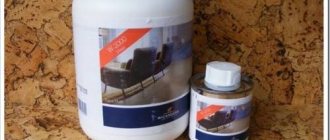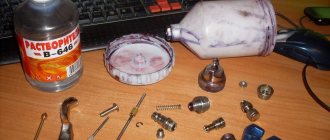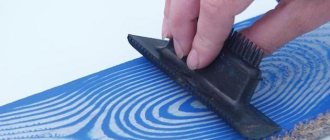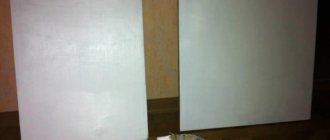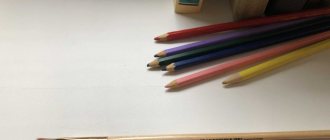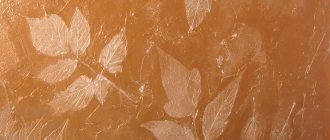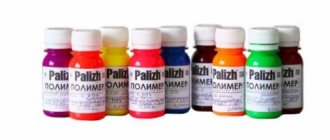What can and cannot be used
Most professional artists resort to solvents from specialized stores, but other artists are quite happy with home tools that can always be found at hand.
Professional products
If we consider products from specialized stores, they will be:
- thinners (suitable for all types of brushes);
- brush washer;
- soap for washing brushes.
Thinners destroy the chemical structure of oil paint, and therefore it is easier to wash off the bristles (it is better to use white spirit).
A brush washer is an interesting device consisting of a spring fixed above a small vessel. Thinner is poured into it, the brushes are placed in the spring, and their bristles are soaked in the poured product.
Soap for washing brushes is used after excess paint has been removed from the bristles, and the brushes themselves have been in thinner.
Home Remedies
At home, the following are used to clean oil paint from brushes:
- washing powder;
- dishwashing detergent;
- laundry soap;
- gasoline and kerosene.
When using washing powder , you must first make a concentrated solution of detergent and a small amount of warm water, then dip your brushes in it, periodically rinsing the bristles with running water and wiping with a cloth.
In the case of dishwashing detergent, it is even easier - you just need to rinse the bristles in the detergent, and then in water.
The procedure for using laundry soap is the same as in the method with detergent.
Gasoline and kerosene are precisely the substances that can be used to clean brushes from oil-based paints, but are not necessary.
Toxic products can greatly harm brushes made of synthetics and bristles, but if there is no other choice, you can quickly dip the dried tool in liquid and just as quickly remove it by wiping it on a cloth.
How to clean makeup brushes
1. Baby shampoo
For many years I have been washing my brushes with baby shampoo. During all this time, they did not lose their shape, but, on the contrary, retained it.
How to wash makeup brushes with shampoo
First, squeeze a drop of baby shampoo onto a cotton swab. Carefully dip the brush into the detergent. “Twist and twirl” on the palm until the bristles of the brush are clean. Rinse with water.
Bottom line: this method is suitable for brushes that only you use. If you work as a makeup artist, then you definitely need to disinfect your brushes! And the next option is just for you.
2. Special products for cleaning brushes (Makeup Brush Cleaners)
Similar liquids can be found in every brand. This applies not only to professional, but also luxury brands, for example:
- Bobbi Brown Conditioning Brush
- Clinique Makeup Brush Cleanser
- Estee Lauder Makeup Brush Cleaner
- Mac Cosmetics Makeup Brush Cleanser - I use it to wash my “working” brushes (read the review here).
How to wash your brushes with a special brush cleaner
I talked about this in detail in the article “How to wash brushes using a special product”
Bottom line: the difference between these products is that they contain alcohol, which is necessary for disinfecting brushes!
If you are afraid that alcohol will have a bad effect on the pile, then this is not so. A certain amount of alcohol has long been calculated in such products and believe me, they are not intended to destroy brushes, but only to disinfect them.
3. Tea tree oil
It has been noticed that tea tree oil has antibacterial properties, although not as strong as previous products.
How to Clean Your Brushes with Tea Tree Oil
- Add 3-4 drops of tea tree oil to a container of warm water.
- Lower the brush and rinse.
- To make sure your brushes are clean, you can add one teaspoon of baby shampoo.
Bottom line: I have never tried this cleaning method, but I have heard about it as the most positive method.
4. Wipes or makeup remover as a way to clean brushes (Makeup Remover Wipes)
This method is convenient when traveling when you don’t have any oil, special product, or baby shampoo on hand! I am sure that not a single girl will forget to take makeup remover on a trip. This is exactly what will help your brushes out.
How to Clean Your Brushes Using Makeup Remover Wipes
- Soak a cotton swab in makeup remover
- Run the brush over it a couple of times until it's clean.
- The same can be done with napkins - using circular movements of the brush until completely clean.
5. Laundry soap
The only product that completely removes creamy textures from your brushes! This applies to watercolor paints, waterproof cream eyeshadows and foundation.
How to clean brushes with laundry soap
- Swipe the brush over the soap a couple of times
- Using circular movements on the palm, cleanse.
- Rinse with water.
Bottom line: I am completely calm about the condition of the brushes after this method of cleaning, since when working with cream textures you are only dealing with synthetic, not natural bristles. This is the only soap I can use to wash my brushes after creative makeup.
Rules for caring for art brushes
Brushes are not the cheapest painting tools, but with proper care they will last a long time. Timely and competent hygiene before storage is the main apostle of proper care:
- Immediately after cleaning the brushes of any type of paint, you need to dry it (wet bristles and synthetics are at high risk of mold), and to prevent the bristles from fluffing up and retaining their shape, when drying, they are tightly wrapped in a paper napkin.
- For convenience, brushes for oil paints are stored in a brush rack immersed in oil.
- If there is no brush washer, then you need to put your brushes in some kind of closed case to prevent dust or moths from affecting the bristles.
Should you wash your brushes with soap? Of course yes.
Probably the most common method for washing brushes . After all, soap easily washes your hands of grease (natural or artificial oils). Absolutely any solid soap will do. If anyone is interested, the less dye and different flavors in the soap, the more natural it is, but I think this can be omitted. Our main task is to wash the brushes .
Mode of application:
Take the soap in one hand, and the other brush, moisten it and the soap with running water. After this, we begin washing in a circular motion, moving the brush over the surface of the soap until foam forms. At this moment, the paint is washed away from the brush bristles . Rinse the brush with water and repeat until the brush is completely clean.
In art stores you can find soap for cleaning brushes .
How to wash a palette of paints
It is best to wash any (except paper) palette, like brushes, immediately after finishing work. The plastic palette is very easy to clean: the same thinners, detergents, washing powders and laundry soap will come to the rescue and will not let you down. But in the case of getting rid of oil paint on a wooden palette, there are several nuances that really affect the choice of cleaning products:
- If a wooden palette is not varnished and oil paint remains and has dried on it, the palette can be thrown away, since it is impossible to get rid of pieces of paint without damage.
- If the wooden palette is covered with nitro or oil varnish, for example, acrylic-pistachio, then you need to scrape off the dried paint from the surface with something sharp, and then linseed or safflower oil, special oil will help. thinners for oil paint. Finally, the palette should be wiped with a damp cloth.
Brush washer for cleaning brushes.
A brush washer is a funny thing that consists of a vessel and a spring above it. You can pour thinner into it and secure the brushes so that the bristles are immersed in it. And after washing, you can store the brushes by replacing the thinner in the brush tray with oil (you can even use sunflower oil), dipping the tips of the brush into the oil, you will know that they are completely safe.
Some artists, often beginners, not being sure that the brush is clean, place it in water. There is a part of rationality here, water does not allow air to pass through and does not allow the brush to dry out. And the brush itself can deteriorate, since it is better to store them in an upright position and with the nap facing up.
Wash your paint brushes well , and we will discuss their safety in another article. A clean brush is the key to your quality work. I wish you success and creative heights!
Which brushes to choose for oil painting? Fleitz, what kind of brush is it? Thinner for oil paint. Which to choose? Which palette to choose for oil painting? Types of canvases for painting, which one to choose.
How to wash paint tubes
Keeping tubes of oil paint clean is a must for any artist who doesn’t want unnecessary headaches. You can get rid of oil paint stains on the tube body itself using:
- thinners;
- laundry soap;
- dishwashing detergent.
Any of the above products is applied to the surface and wiped off with a regular sponge. As for the dried oil paint that has peeled off under the lid, in this case it can be cut off even with a simple stationery knife.
If you take good care of all your painting tools, you can keep them in working condition for quite a long time, and by using gloves when cleaning (especially when using toxic substances), you can protect the skin of your hands from negative consequences.
What types of brushes are used during painting work?
Every person who has at least once carried out renovations in an apartment on their own is well aware that in order to perform high-quality work, several different types of brushes are required. Thus, priming surfaces, painting ceilings and walls of a room using water-soluble acrylic products requires the use of large flat brushes. For working with oil and some other types of paints, small round or flat brushes, called flutes, are quite suitable.
Types of brushes
In any painting process there are certain breaks, during which the functional properties of the brushes must be preserved in their original state - this will help avoid the need to purchase a new product and save you money and time.
What to do if the gel polish brush has hardened?
If you accidentally dropped a brush with gel polish or forgot about it, and it came under the rays of an ultraviolet lamp, do not rush to throw away the tool. It can be washed off with a brush from gel-based nail polish even in such a situation!
- Wet the brush with cleanser for fifteen minutes.
- Place the tool on a hard, flat surface and fluff the bristles like a fan.
- Using an orange stick, carefully remove any remaining gel polish.
- Rinse the pile with warm running water.
All that remains is to give the bristles its original shape and dry it.
Cleaning the instrument before a short break
If during painting work you need to pause for 1-2 hours, then in order to avoid loss of quality of the brush, it needs to be given appropriate attention, which consists in the process of removing the color mixture from the pile. The need for this arises due to the fact that most of them dry extremely quickly, after which it can be quite difficult to remove the paint, and in some cases it is completely impossible
Some craftsmen, most often inexperienced, often prefer to place the tool with the working surface in a container containing water. When resorting to this method, it should be borne in mind that although during such a procedure the paint does not thicken in the pile, because of this it becomes an order of magnitude harder and, as a result, the quality of painting performed in the future decreases.
Taking into account this feature, instead of dipping the brush into a container of water, it is better to place it in an ordinary plastic bag or thin food-grade aluminum foil.
As a result, the instrument must be wrapped in any of the specified materials in such a way as to prevent the penetration of air inside. Using this method, you can achieve preservation of the quality of the paint brush within 2 hours.
How to store brushes?
It is important not only to thoroughly and carefully wash your brushes after applying gel polish, but also to store them correctly.
Dried, cleaned brushes are stored strictly horizontally in a special case. It is important to provide conditions under which the brushes will not gather dust, wrinkle, or come into contact with other manicure tools. A master working in a salon should have several brushes of the same name in case he drops a brush or has already stained the necessary tool with gel polish and did not have time to clean it.
